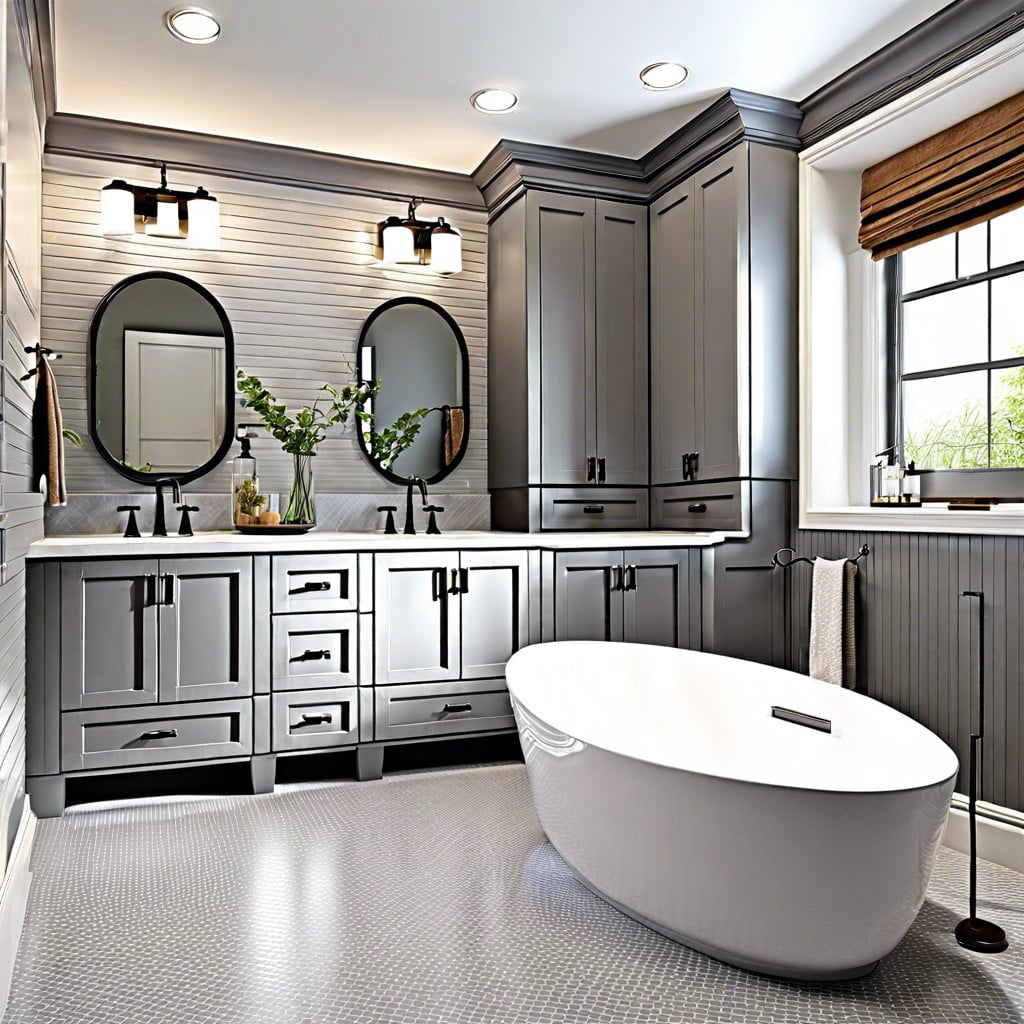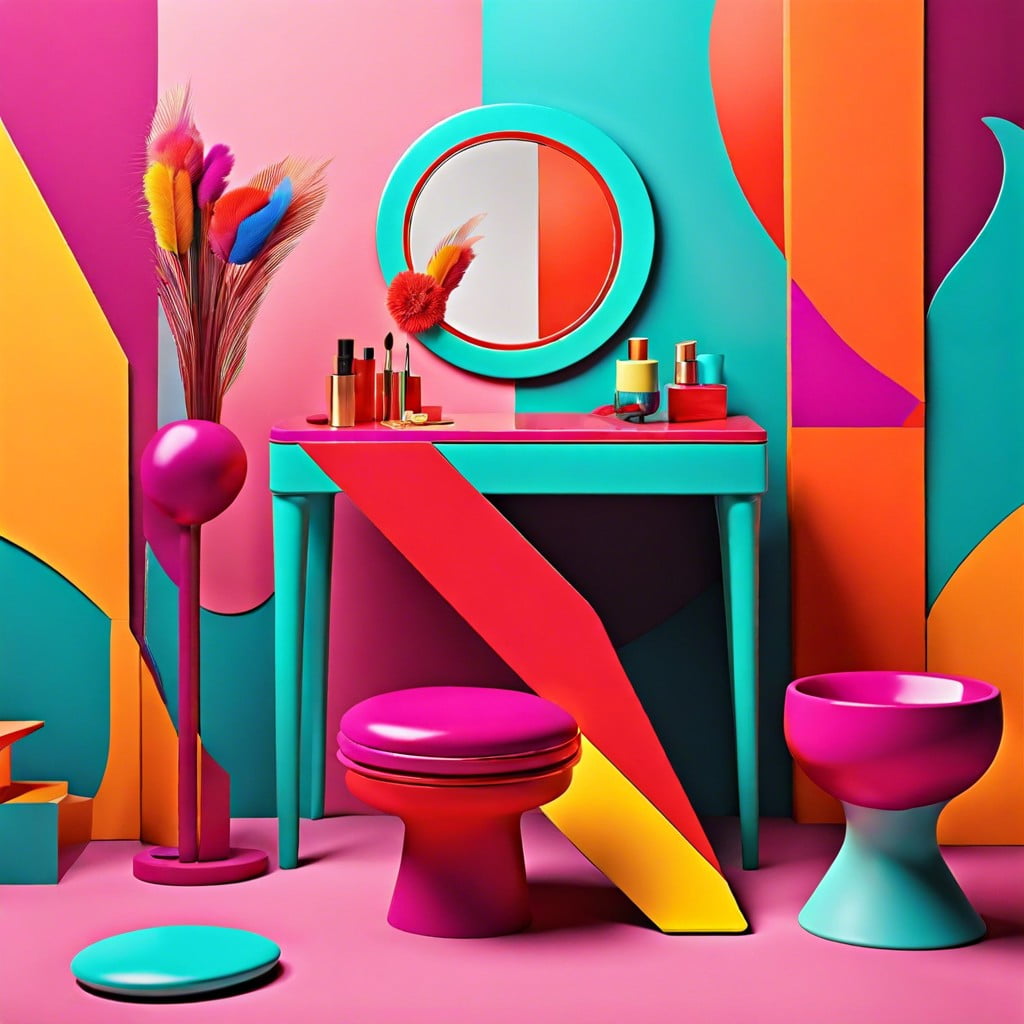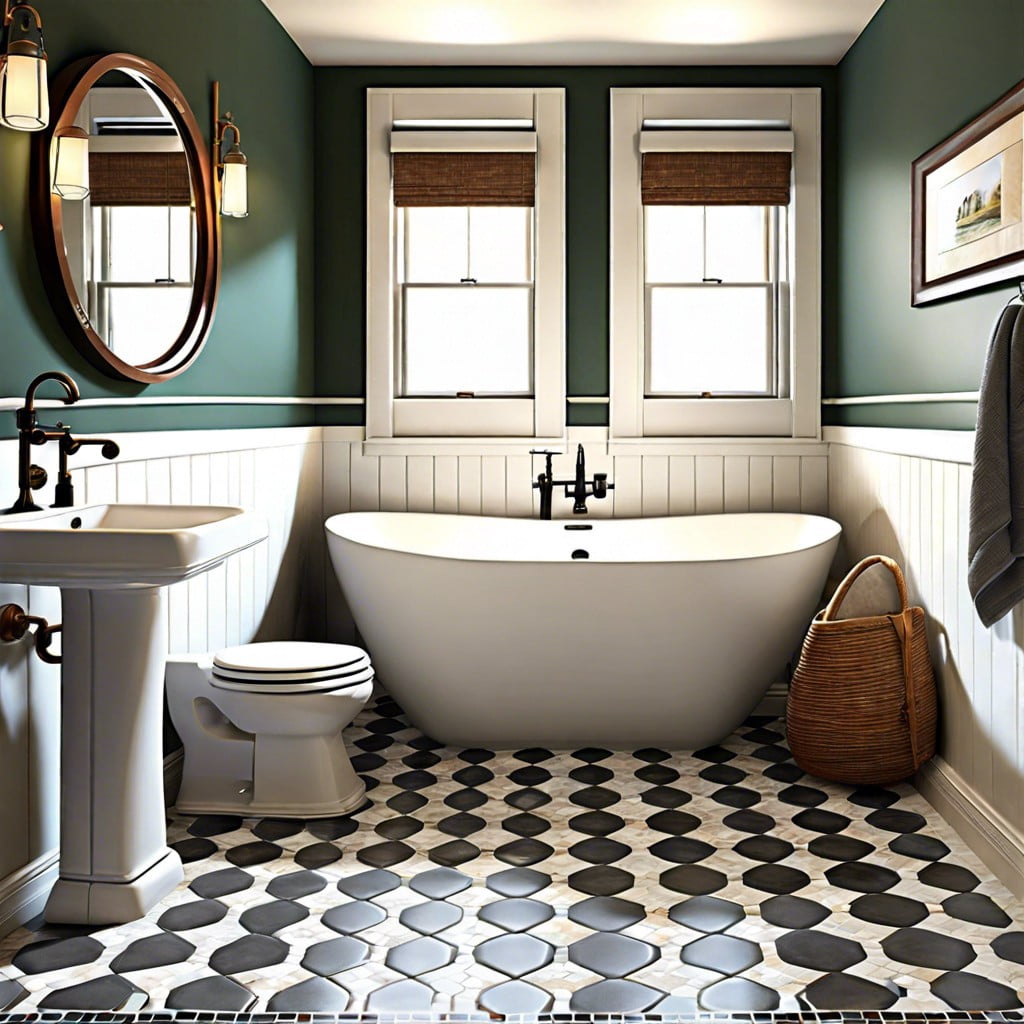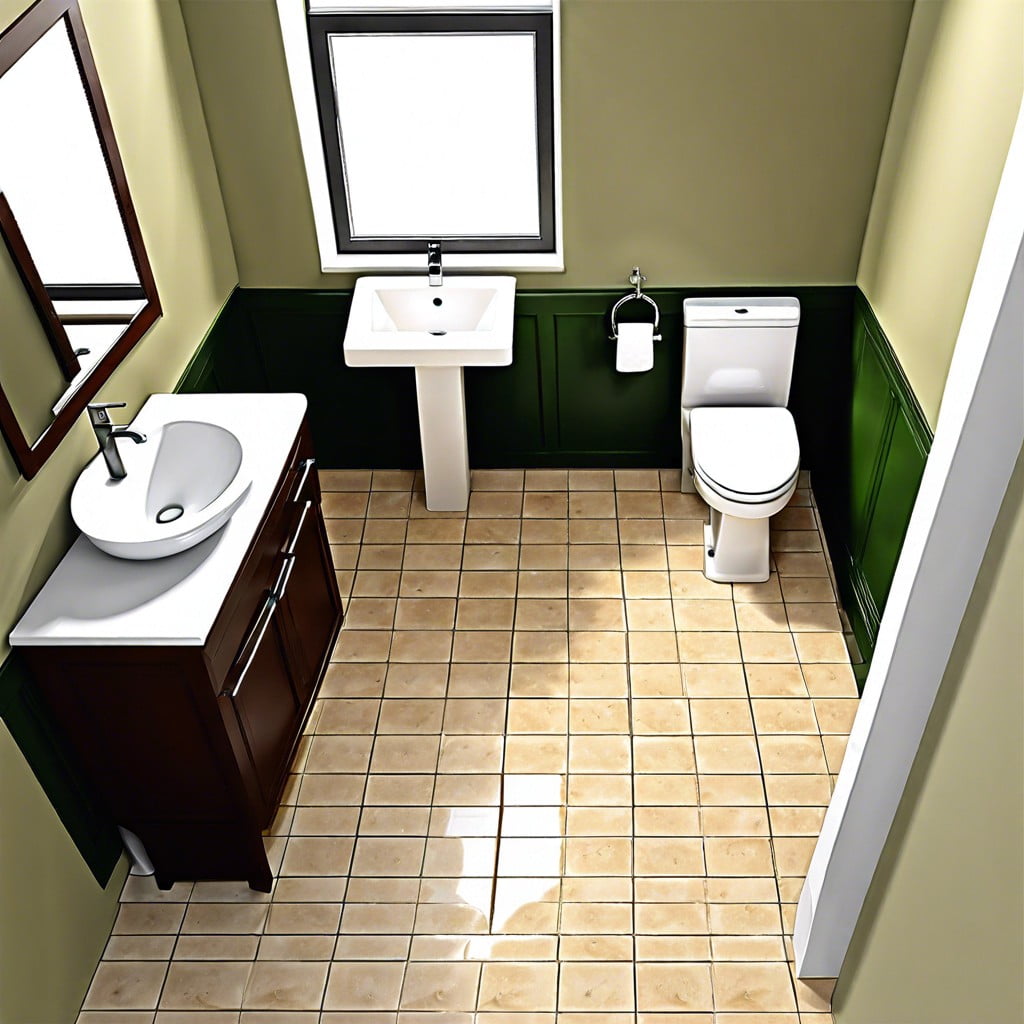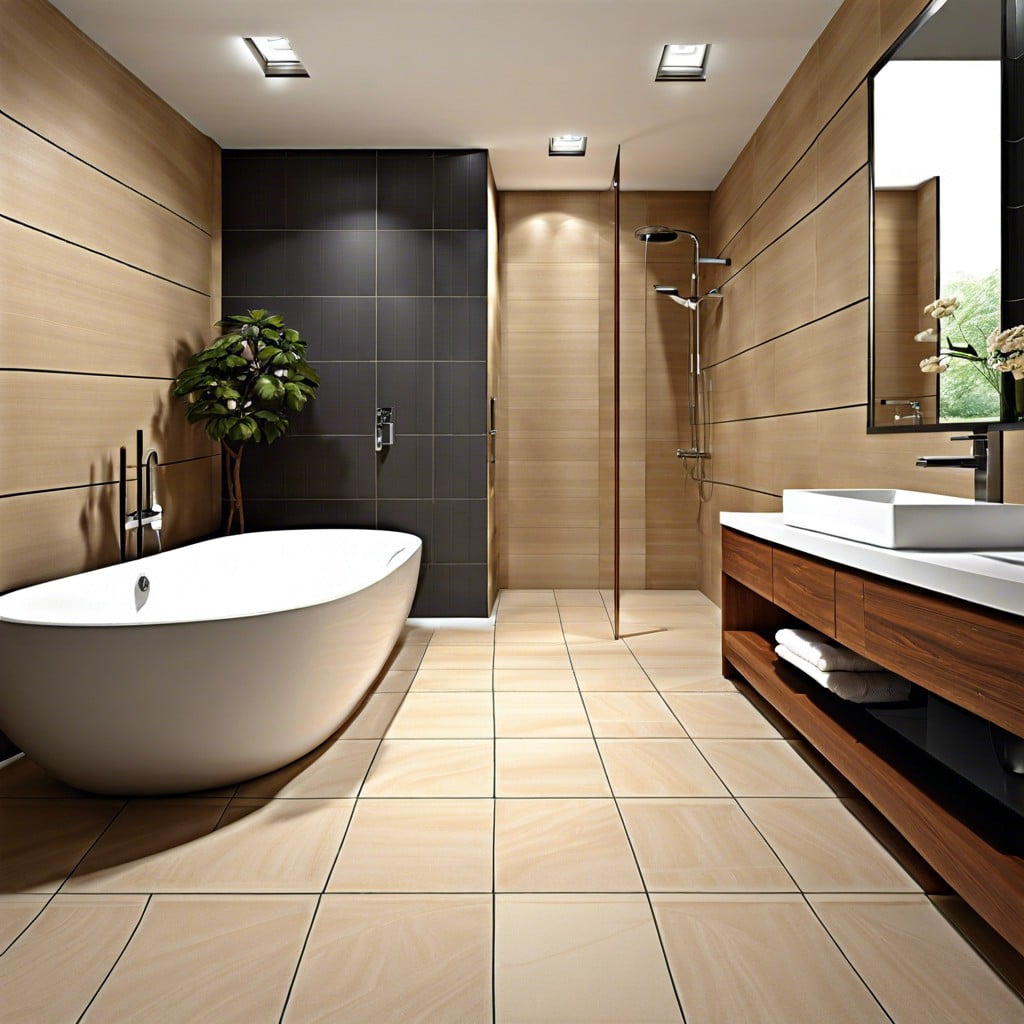Last updated on
In the following discourse, learn how selecting the right paint color can effortlessly transform a small bathroom into a visually expansive and elegant space.
Key takeaways:
- Pale colors create an illusion of space and airiness.
- White paint is classic, versatile, and makes the space look bigger.
- Dark green adds sophistication, but use it in moderation.
- Lighting affects paint perception, use glossy finishes and consider the color temperature.
- Simplicity with a single color palette enlarges the space visually.
The Illusion of Space With Pale Colors
Pale colors are not just a safe choice; they’re a strategic move in small bathrooms. They reflect light, making walls seem to recede, and give a sense of airiness.
Imagine soft blues echoing the serenity of the sky, or light grays providing a neutral but sleek backdrop. These hues provide a clean canvas, allowing fixtures and accessories to stand out without overwhelming the space.
Employing pale tones helps blur the boundaries of the room’s dimensions, effectively ‘expanding’ the visual square footage—a neat trick for tight quarters.
White: Classic and Expansive
Opting for white paint in a small bathroom is a choice that never goes out of style. This hue reflects light, making the walls seemingly recede and therefore contributes to a perception of a more expansive space.
White’s versatility allows it to blend seamlessly with any design elements, from stark modern fixtures to cozy vintage accessories.
It’s not just about making the space look bigger; it’s also about creating a clean canvas that lets other features, such as artwork or bold fixtures, truly pop.
White can be warmed with soft textures or kept crisp with glossy finishes, catering to a wide range of aesthetic preferences.
Moreover, it lends itself to play with textures and patterns without overwhelming the senses—a trick particularly useful in small spaces.
Dark Green: Statement Color in Moderation
Embracing dark green in a small bathroom can infuse the space with sophistication and depth. Use it on one wall to create a focal point without overwhelming the room.
This hue pairs exquisitely with natural wood or brass fixtures, promoting an earthy, grounding atmosphere. For balance, keep adjacent walls in lighter shades to avoid a cavelike feel.
Opt for glossy finishes; they reflect light better, making the color shimmer and enhancing the perception of space. Remember, moderation is key—too much dark green can shrink the room visually.
Contrast with light-colored towels and accessories to break up the monotony and add a touch of elegance.
The Role of Lighting in Paint Perception
Lighting dramatically affects how paint colors present themselves in a small bathroom. It can manipulate the mood and even the perceived size of the space. Here’s a dive into this phenomenon:
- Natural light tends to reveal true color and reflectivity. Glossy finishes bounce light around, helping small bathrooms feel larger.
- Artificial lighting comes in various temperatures. Warm lighting can make cool tones appear more muted, while cool lighting can invigorate warm colors.
- Directional lighting creates shadows and highlights, adding dynamism or making a space feel cramped. Consider diffused lighting for a more even, expansive look.
- LEDs offer a spectrum of color temperatures. Choose daylight bulbs for a natural feel or soft white to craft a cozy atmosphere.
Understanding the interplay of light and color can turn a cramped bathroom into a serene retreat or a vibrant jewel box.
Simplicity: The Impact of a Single Color Palette
When considering a single color palette for a small bathroom, simplicity reigns supreme. The uninterrupted flow of one color or shades of the same hue enlarges the space visually. Here’s why keeping it simple works:
- Continuity: A unified color scheme avoids visual disruption, allowing eyes to glide effortlessly over surfaces without the jarring pauses that multiple colors can create.
- Cohesion: Variations of one color, from light to dark, add subtle depth and texture without overwhelming the small area.
- Versatility: A monochromatic scheme serves as a neutral background, making it easier to switch up accessories and accent pieces without committing to a new paint job.
- Serenity: Fewer colors translate into a more tranquil and decluttered feel – essential in a space where relaxation is key.
FAQ
What’s the best color for a small bathroom?
In my view, light gray is unbeatably the best color for a small bathroom as it effortlessly creates an illusion of more space.
What colors make a small bathroom look bigger?
Light shades like white, crème, pastel blue, gray or yellow can visually expand a small bathroom, while dark hues like deep red, green or brown can make it seem more confined.
What colors are most flattering in a bathroom?
In the realm of bathroom aesthetics, neutral colors such as light grays, warmer off-whites, and calming, soft blue-greens hold the upper hand as the most flattering choices.
Should a small bathroom be painted light or dark?
In my perspective, a small bathroom should ideally be painted in very light shades to maximally brighten and enlarge the space, adopting those hues with a higher Light Reflective Value (LRV) that best reflect the mood you wish to evoke.
How does the psychology of color apply to small bathroom design?
The psychology of color in small bathroom design plays a crucial role, where lighter shades can make the area appear more spacious and serene, while darker tones can add a sense of richness and depth, but might make the space seem smaller.
What influence does the color of bathroom fixtures have on the overall aesthetic?
The color of bathroom fixtures significantly impacts the overall aesthetic by dictating the mood, ambiance, and style characteristic of the space.
Can patterned wallpapers be utilized effectively in small bathrooms?
Absolutely, patterned wallpapers can indeed be a remarkable asset in small bathrooms, providing an interesting visual appeal and a sense of enlarged space.
Recap
